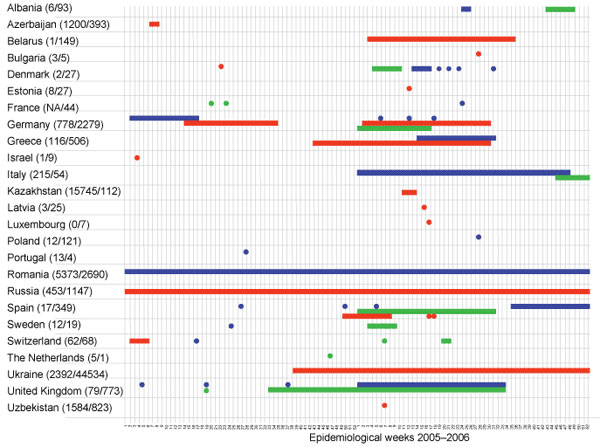High Genetic Diversity of Measles Virus, World Health Organization European Region, 2005–2006
Jacques R. Kremer*

, Kevin E. Brown†, Li Jin†, Sabine Santibanez‡, Sergey V. Shulga§, Yair Aboudy¶, Irina V. Demchyshyna#, Sultana Djemileva**, Juan E. Echevarria††, David F. Featherstone‡‡, Mirsada Hukic§§, Kari Johansen¶¶, Bogumila Litwinska##, Elena Lopareva***, Emilia Lupulescu†††, Andreas Mentis‡‡‡, Zefira Mihneva§§§, Maria M. Mosquera††, Mark Muscat¶¶¶, M.A. Naumova§, Jasminka Nedeljkovic###, Ljubov S. Nekrasova#, Fabio Magurano****, Claudia Fortuna****, Helena Rebelo de Andrade††††, Jean-Luc Richard‡‡‡‡, Alma Robo§§§§, Paul A. Rota***, Elena O. Samoilovich¶¶¶¶, Inna Sarv####, Galina V. Semeiko¶¶¶¶, Nazim Shugayev*****, Elmira S. Utegenova†††††, Rob van Binnendijk‡‡‡‡‡, Lasse Vinner¶¶¶, Diane Waku-Kouomou§§§§§, T. Fabian Wild§§§§§, David W.G. Brown†, Annette Mankertz‡, Claude P. Muller*, and Mick N. Mulders¶¶¶¶¶##
Author affiliations: *World Health Organization (WHO) Regional Reference Laboratory for Measles and Rubella, Luxembourg, Luxembourg; †WHO Global Reference Laboratory for Measles and Rubella, London, United Kingdom; ‡WHO Regional Reference Laboratory for Measles and Rubella, Berlin, Germany; §WHO Regional Reference Laboratory for Measles and Rubella, Moscow, Russian Federation; ¶Israel Ministry of Health, Tel Hashomer, Israel; #Ministry of Health, Kyiv, Ukraine; **Ministry of Public Health of the Republic of Uzbekistan, Tashkent, Uzbekistan; ††Instituto de Salud Carlos III, Majadahonda, Spain; ‡‡WHO, Geneva, Switzerland; §§University of Sarajevo, Sarajevo, Bosnia and Herzegovina; ¶¶Swedish Institute for Infectious Disease Control, Solna, Sweden; ##State Institute of Hygiene, Warsaw, Poland; ***Centers for Disease Control and Prevention, Atlanta, Georgia, USA; †††National Institute for Research and Development in Microbiology and Immunology “Cantacuzino,” Bucharest, Romania; ‡‡‡Institut Pasteur Hellenique, Athens, Greece; §§§National Centre of Infectious and Parasitic Diseases, Sofia, Bulgaria; ¶¶¶Statens Serum Institute, Copenhagen, Denmark; ###Institute of Virology, Vaccine and Sera Torlak, Belgrade, Serbia; ****Istituto Superiore di Sanità, Rome, Italy; ††††Instituto Nacional de Saúde Dr. Ricardo Jorge, Lisboa, Portugal; ‡‡‡‡Swiss Federal Office of Public Health, Berne, Switzerland; §§§§Institute of Public Health, Tirana, Albania; ¶¶¶¶Ministry of Health, Minsk, Belarus; ####Health Protection Inspectorate, Tallinn, Estonia; *****Ministry of Health, Baku, Azerbaijan; †††††Ministry of Health, Almaty, Republic of Kazakhstan; ‡‡‡‡‡Rijksinstituut voor Volksgezondheid en Milieu, Bilthoven, the Netherlands; §§§§§INSERM U404, Lyon, France; ¶¶¶¶¶WHO Regional Office for Europe, Copenhagen, Denmark;
Main Article
Appendix Figure 1

Appendix Figure 1. Schematic view of genotype B3 (green), D4 (blue), and D6 (red) circulation in the World Health Organization European Region during 2005–2006. Bars indicate continued circulation of the same genotype in a country. The time span was delimited by the first and last case associated with highly similar variants of the same genotype and does not reflect the full duration of circulation when genotyping was not performed at the beginning and at the end of an epidemic. Dots represent single sequences obtained from sporadic cases or outbreaks. Numbers of reported measles cases per country in 2005/2006 are also shown.
Main Article
Page created: July 07, 2010
Page updated: July 07, 2010
Page reviewed: July 07, 2010
The conclusions, findings, and opinions expressed by authors contributing to this journal do not necessarily reflect the official position of the U.S. Department of Health and Human Services, the Public Health Service, the Centers for Disease Control and Prevention, or the authors' affiliated institutions. Use of trade names is for identification only and does not imply endorsement by any of the groups named above.
